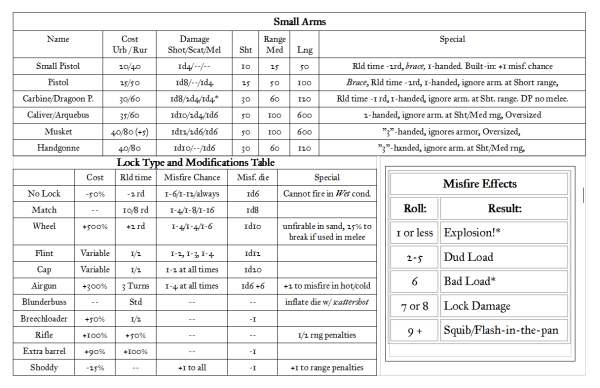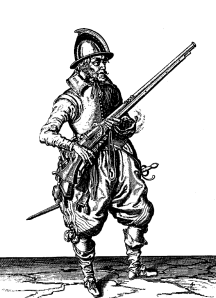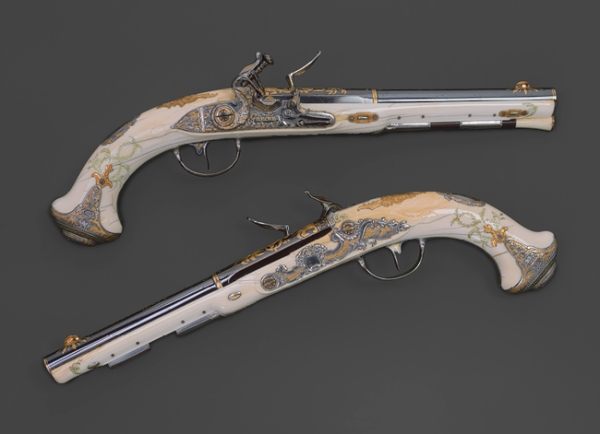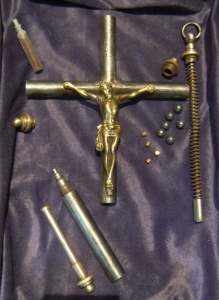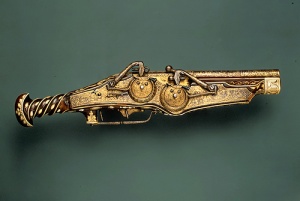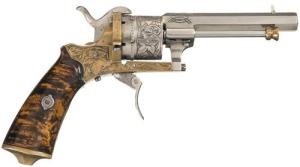I’m putting together campaign materials for my Colonial game. Today, it’s time to update my last post on firearms with some more specific stats for the guns. Working on a misfire table for my own use, which I finally finished (here)
The usual disclaimer: These are intended for Lamentations of the Flame Princess, but suitable for pretty much any RPG with hit dice. As always, LotFP uses the Silver standard, so bump up prices to GP if you’re one of those folks. Encumbrance also works uniquely, based on number of items and their clumsiness, rather than on weight per se. I’ve listed standard weights for each weapon type as a nod to the AD&D folks out there.
Weapon:

Handgonne:
Quite literally a hand cannon, the handgonne has a short barrel and a touch-hole (see: “No Lock” in my previous post). They suffer from a cannon’s standard to-hit penalties. They may, however, be hooked onto a stable surface or fired with a second crew member rather than fired from the carry; they then suffer only a -5 penalty to hit targets smaller than a house, & gain a +2 to hit larger targets. They weigh anywhere from 15 to 30 or more pounds, and count as a single Oversized item.
Range: As Pistol
Dmg: 1d10, or 1 ship-scale HP, ignores all armor less than AC 15 at all ranges
Reload time: As Musket.
Caliver:
The Caliver (from which the word “caliber” is derived) is a light-weight long gun. Well, light by the standards of the day – most still weighed well over 10 lbs. A caliver is what most are thinking of in the modern era when they say “musket”. Calivers were standardized at what we now call 20-gauge, Id Est, 20 round lead shot the diameter of the barrel will weigh one pound. Calivers may be fired from the shoulder without penalty.
Range: as LotFP Musket.
Damage: 1d8, ignores all armor less than AC 15 at all ranges. May be used as a club in close combat for 1d6 damage.
Cost: 40sp City, 80sp Rural.
A Caliver is an Oversized item.

A Musketeer, again from De Gheyn. Note the lanyard on the rest, which allows quick recovery when reloading.
Musket:
A substantially more powerful weapon, the Musket is a 12-gauge gun, or a bit over .70 caliber. They also load a much heavier powder charge, kick like mules, and take three “hands” to fire effectively – see Rests, below.. A historical musket could weigh upwards of 25lbs, and was made sturdily enough to use as a melee weapon. The heavy diamond-shaped stocks on most muskets added considerable authority to a good smack upside the head with one, which was quite helpful in the years before the bayonet (plug bayonets were only invented around 1700, and latching bayonets that didn’t block the barrel wouldn’t show up for several decades thereafter).
Range and cost as standard LotFP muskets.
Damage: 1d12, ignores all armor less than AC 17 at all ranges. 1d6 damage when used in close combat.
Muskets count as one Oversized item (the musket itself) AND one Standard item (the rest).

Carbine/Dragoon’s Pistol:
Basically, a sawed-off caliver or a very long pistol. They were designed to be portable and powerful, and were occasionally carried as back-up weapons by pikemen or halberdiers. The carbine counts as a single item, and may not be combined into a brace. It may also be conveniently holstered on a saddle or even a character’s thigh, being about the size of a good sword. They may be fired with one hand, weighing only around 5-10 lbs.
Range: 30/60/120 feet
Damage: 1d8 (2d3 for scattershot, 2d4 if a blunderbuss), ignores all armor less than AC 15 at short range. Does 1d4 damage when used as a club.
Cost: 30sp City, 60sp Rural
Carbines reload 1 round faster than long guns. Note that, like other bonuses, this is subtracted >before< a halving effect such as a flintlock or breech-loading modification.
Miscellaneous items:
Flints tend to break after only a few shots, and need to be constantly sharpened. Characters are, however, assumed to take care of this outside combat if they have a flint nodule, costing 6 coppers. If deprived of flint, or time to knap new ones, a flintlock or wheel-lock gun will become unusable after 2d6 shots. 1d6 flints may be improvised from a tinderbox, but increase the gun’s misfire chances by 5%. A flint nodule or knapped flint is a Negligible item.
Cartridges: Not the modern metal-cased cartridges, these are waxed paper packages of powder in a waterproof satchel. They reduce reload times by one round, and decrease the chances for misfire in the damp by 5%. They modify fire saves and cause damage if ignited in the same way as a powder horn. Cartridges cost as much as a single shot of powder, and may be prepared by any character with a gun in their downtime (basically, in the same manner as flints, it’s unimportant to track under most circumstances; assume a character on the run has 2d6 cartridges prepared if they don’t specify a number beforehand). A sack of cartridges is a Standard item.
Gun Rest: A standard musket rest costs 5sp. This price is consistent in urban or rural settings. A rest counts as an additional “hand” when firing a long gun; the character may hold a sword or other item ready for use in the off-hand while shooting any weapon that requires 2 hands. See also below, for hybrid rests. A rest weighs about 5 lbs, and counts as a single Standard item for encumbrance purposes.
Scattershot and Armor: Improvised scattershot, shots from a blunderbuss, sling stones, and bullets from pellet bows do not ignore armor, regardless of the strength of the user or the size of the gun.

A box full of very bad ideas.
Weapon Modifications:
Blunderbuss modification: The gun can no longer fire slugs. Halves range. Upgrades shot damage to 2d6 for long guns; all other shot rules remain intact. Improvised shot may still be used, at the usual 2d4 for damage.
Double-barrel modification: Cannot be applied to a Musket. Adds 90% to the weapon’s cost. Adds a 5% chance of misfire. Both barrels can be fired simultaneously, but the user must save vs. Poison or break an appropriate part of their body and/or the gun. Reload times are as normal for each barrel. Each additional barrel added beyond the second adds the same cost and misfire chance, and the Poison save if all barrels are fired is penalized by -4.
Breech-loader: Double the base price of the gun, and halve reload time. As with a Flintlock, bonuses are counted before this halving effect, and Fighters round down while all other classes round up. A standard misfire (in this case, misfires caused by dampness are ignored) has a 25% chance of destroying the gun and inflicting 1d6 HP of damage on the gun’s user.

Note that other concealable “hold-out” pistols, such as these, follow the same rules as Tack-On guns
Tack-on pistol: A small-caliber pistol may be built into virtually anything. A tacked-on pistol may not use scattershot. They do not increase the Encumbrance category of the item, and two hold-out pistols may be carried as a Brace. A tack-on pistol adds 5% to the lock’s base Misfire chance.
Range: 10/25/50.
Damage: 1d4. Can be fired in close combat, but cannot be used as a club. Does not ignore armor.
Cost: 25 sp Urban, 50 sp Rural
Reloads as a pistol

A French musketeer using a Hybrid Rest
Hybrid Rest: For a cost of 2sp a musket hook can be added to any polearm. It inflicts a -1 to-hit with the polearm in close combat. This was one of the usual solutions to the problem the bayonet solved; a character may ready the polearm simply by dropping their gun, and be ready to receive a charge immediately.

